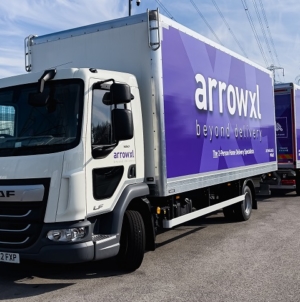-
ROSSLARE EUROPORT TARGETS HEALTH & SAFETY WITH CAMERA TELEMATICS PARTNERSHIP - 2 days ago
-
Landmark Study Reveals Wearable Robotics Significantly Boost Safety and Efficiency in Industrial Environments - July 24, 2024
-
Visku Tackle The Retail Seasonality Challenge One Pallet At A Time - July 22, 2024
-
KAMMAC AND BERGEN LOGISTICS STRENGTHEN FASHION & LIFESTYLE SERVICES IN THE UK - July 19, 2024
-
TENTBOX EXTENDS PARTNERSHIP WITH ARROWXL TO SUPPORT INCREASING DEMAND - July 17, 2024
-
The Perfume Shop improves customer journeys while driving profitability in partnership with Scurri - July 17, 2024
-
ZEROMISSION SECURES £2.3M ($3M) INVESTMENT TO ACCELERATE ELECTRIC FLEETS - July 16, 2024
-
BCMPA CELEBRATES SUCCESS OF 2024 CONFERENCE - July 15, 2024
-
Best of the Best: Jungheinrich Celebrates Triple International Award Win - July 12, 2024
-
GOPLASTICPALLETS.COM CALLS ON NEW CHANCELLOR RACHEL REEVES TO CONSIDER PLASTIC PACKAGING TAX REFORM - July 10, 2024
How to respond to Amazon’s operational capabilities and influence on retail.
Comment by Ian Jindal ,an experienced multichannel retailer and Editor-in-Chief and Founder of InternetRetailing.
With one of the leading eCommerce markets in the world, turning over an estimated £26bn in 2015 , UK retailers are battling global giants such as Amazon to win over customers. Ian Jindal, Editor and InternetRetailing Magazine, indicates how Amazon has dominated the industry and advises on the steps retailers can take to rival their success.
Zoologists would make us believe that there are only two kinds of elephants, the African and the Asian.
However, few rarely indicate the third kind, the one that is in the room – that no one wants to discuss. Except in the retail – and retail logistics world – there is an elephant in the room people can’t stop talking about, and that’s Amazon. The giants seem to have the rest of the retail world permanently on the back foot.
In the recently published 2017 InternetRetailing EU Top 500 report, Amazon didn’t make it into the Elite category. But don’t let that fool you. It continues to dominate the hearts and minds of the customer, and as such manages to dictate developments in retail fulfilment.
Dominance of Amazon
So, how big really is Amazon? In 10 years, Amazon’s market value increased by 1,934% to become the biggest online merchant by 2016, overtaking most of America’s physical retailers combined. 2016 saw American market leaders Sears, JCPenny, Macy’s, Target, Walmart and Best Buy take a combined $298bn, an extraordinary amount in a suffering global economy. However, when we see Amazon taking $356bn alone,2 how can traditional retailers compete?
Amazon recently had its most successful Prime Day to date with sales growing more than 60% from 2016. But, how and why have Amazon excelled within the retail sector?
Ecommerce has always been about keeping your promises to the customer. In the earliest days, those promises tended to be about whether a site could be trusted. But now that promise is more tightly aligned with the customer experience.
Delivery needs to keep the promises ecommerce makes to the customer, and if there’s one thing Amazon seems to have been getting consistently right for several years now, it’s that. So much so, that even consumers who claim to dislike Amazon will still buy from the marketplace because of its convenience. Operational excellence at scale, providing same-day delivery on a growing range of items across an expanding area of the UK is little short of breathtaking.
Even more impressive is the way Amazon is changing customer expectations of delivery en masse. Consumers expect Amazon to offer faster and faster delivery and they’re expecting that of the entire eCommerce sector. It’s becoming the new normal, and if your business can’t accommodate that, it is going to show. If you can’t keep up, you will get left behind.
[1] http://www.visualcapitalist.com/extraordinary-size-amazon-one-chart/
The Challenges Faced by Logistics
International Cross Border
With a potential marketplace of over 1.13m online shoppers, it pays for retailers to have an online presence. But, no matter where a customer lives they expect to receive their order in a timely manner, a challenge many retailers face.
One issue is retailers must understand the delivery and logistics process which takes place in the areas which they are servicing. Retailers are able to save time and money by understanding local delivery options and consumer preferences.
In Germany an address must be 100% accurate or it will not be delivered, whereas in the Netherlands neighbour delivery is a common practice; where if the consumer is not at home the parcel will be diverted to their neighbour and a note will be left to indicate where it is. But, in Scandinavia consumers prefer to pick up their parcels through locker boxes, which are making a rise in the UK.1
By understanding consumer preferences and the best practices within the countries they are operating, Amazon dominate the marketplace as customers know their parcel will be received in an efficient manner. By operating in this fashion, other retailers can gain loyal customers who are reassured they will receive their order promptly.
Transportation Cost and Capacity
Retailers must maintain a cost effective way to transport their goods from the warehouse to the customer. Usually this comes in the form of external delivery drivers who are paid by the company to make the deliveries, but this can be pricey for smaller retailers. Often these merchants are left to send orders through the countries’ national postal system, which has the potential to lose orders or damage the goods in the process.
Recently we have seen Amazon take major steps to speed up its shipping services with algorithms to anticipate orders, robots picking the items and express delivery which can see an order arrive in a matter of hours. But the problem faced here is how does Amazon deliver to those living in the most remote areas in the same way?
To this they came up with ‘Prime Air’ a drone delivery service set to revolutionise the way consumers receive their packages. Although the majority of retailers can’t foresee drones delivering their packages within the next five years, retailers can be efficient in their delivery to retain customers.
Returns Strategy
Internet returns are usually three times higher than that of the traditional retail store adding a substantial dent to the business’ bottom line. An upper-hand to those competing against Amazon.
Retailers must make the returns process efficient to appeal to customers, making the process simple, efficient and clear will ensure retailers gain those initial orders. 82 percent of online
[1] https://www.digitaltrends.com/cool-tech/amazon-prime-air-delivery-drones-history-progress/
[1] https://compass.ups.com/online-retail-returns-best-practices/
shoppers said they would complete a purchase online if they could return the product for free in-store or with a prepaid label. Yet only 32 percent of the Top 500 retailers offer some form of omnichannel or store-based return.5
The most efficient way retailers can raise their customer service for returns is to add a simple return label and including them in the package which has been delivered. Something Amazon prides itself on.
How Can Retailers Challenge Amazon?
Along with the above suggestions, there are already plenty of signs in the retail sector of the kind of innovation that will be required to face Amazon’s dominance. The Asda toYou service is a great example of a retailer finding ways to monetise what would otherwise be latent capacity in its network – previously empty space in vehicles is now earning its keep, customers are getting new delivery and collection options in familiar, easy-to-access locations, with hopes to attract an extra 40 million visits to its store estate.
Retailers without their own delivery network may want to look at collaborations and partnerships to extend their reach and avoid the pain of significant investments. When it comes to investing in better, more flexible and more efficient fulfilment operations, developments like DHL’s augmented reality glasses, and Honeywell’s voice operated picking technology both point to a future that’s a long way from the traditional view of warehousing.
One theme of discussion at this year’s EDelivery Conference will cover how retailers are able to challenge the dominance of Amazon. Attendees will also be given the opportunity to take part in peer-learning roundtables with industry giants such as IBM, Selfridges, LastMinute, Corra, Whittard and Amazon themselves.
Visitors will experience groundbreaking presentations on logistics and supply chain industry issues such as returns strategy, International cross border delivery and reputation management from Trainline, Deliveroo, John Lewis, ASDA and many more.
To find out more and order your ticket, visit the EDelivery Conference: http://edelivery.net/2017/07/key-themes-2017-edelivery-conference-edc/

































